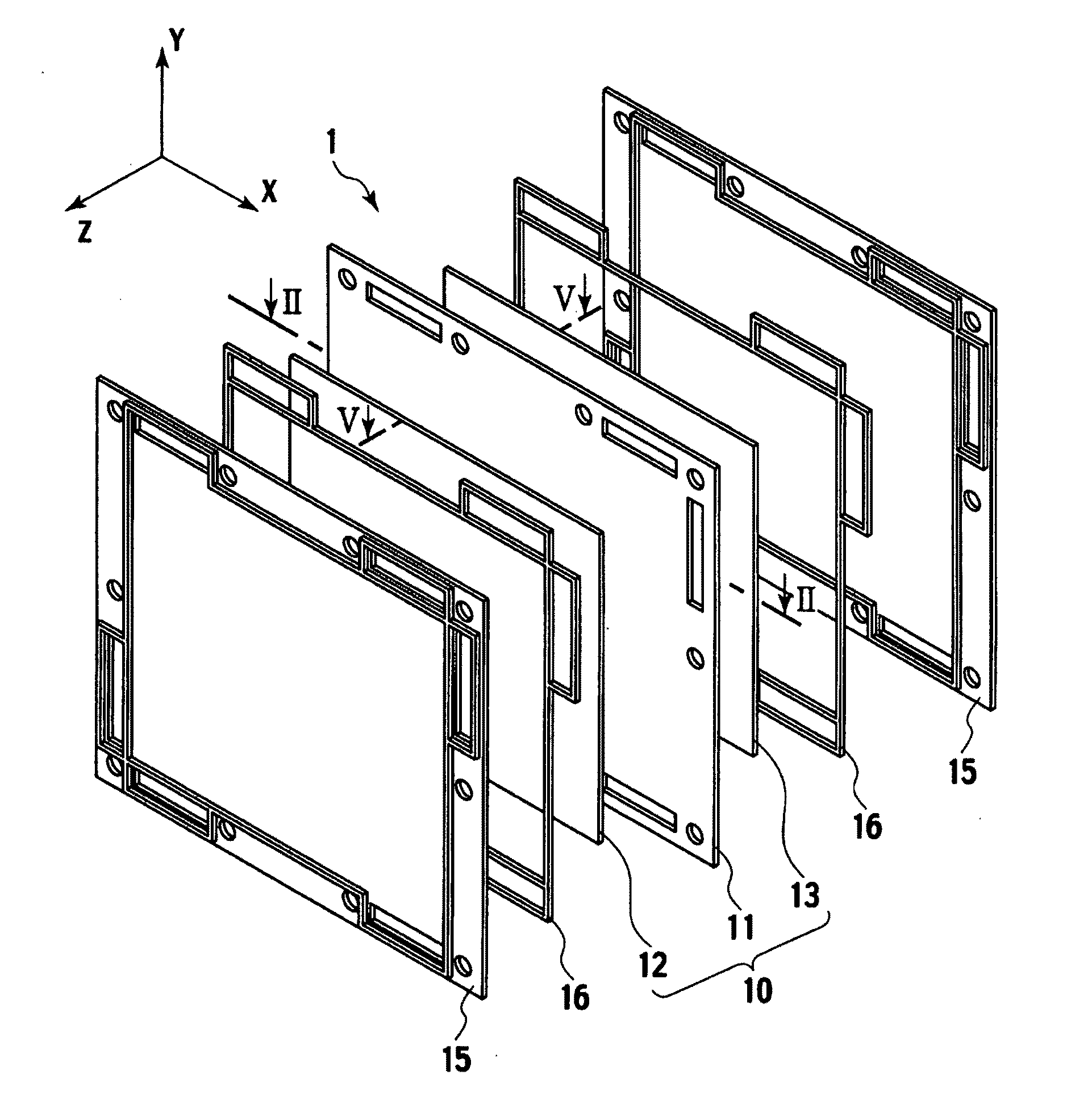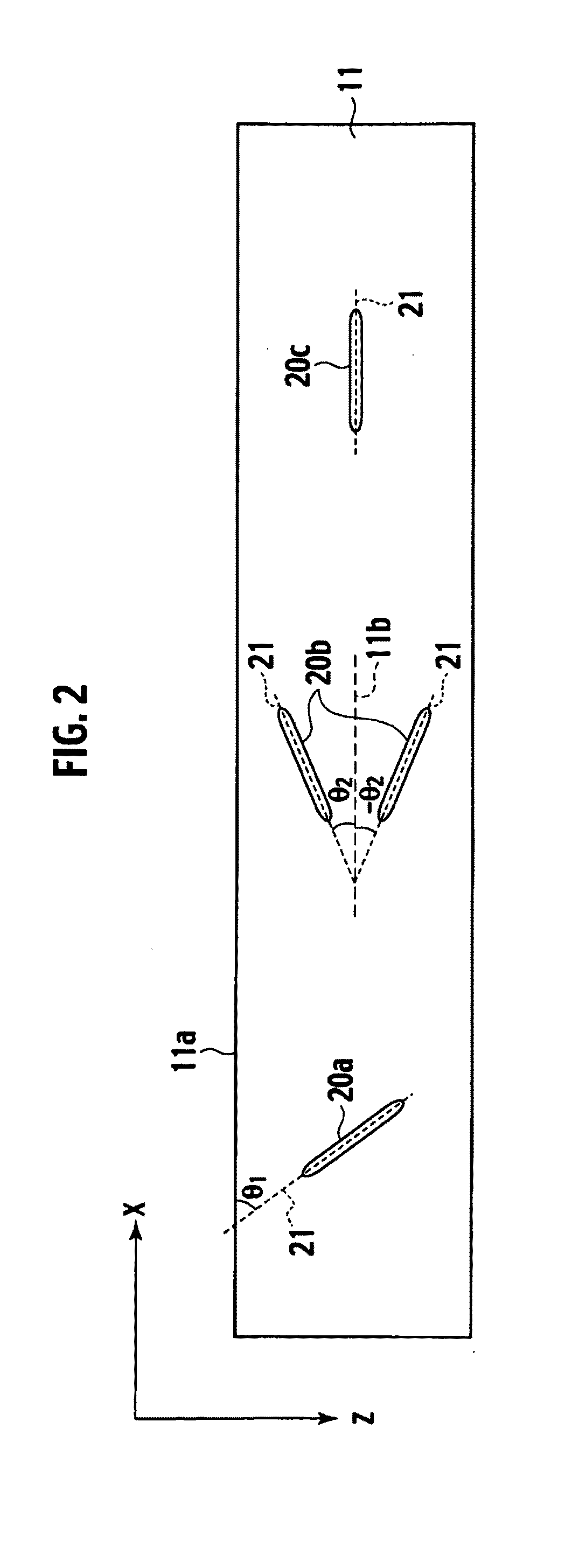Electrolyte membrane and membrane electrode assembly using the same
- Summary
- Abstract
- Description
- Claims
- Application Information
AI Technical Summary
Benefits of technology
Problems solved by technology
Method used
Image
Examples
example 1
Examples where a Content of Titania Filler Differs
[0122]Needle-like titania powder (FTL-100, made by Ishihara Sangyo Kaisha, Ltd.) with an aspect ratio of 12.9 and N-methylpyrrolidone (NMP) were mixed together at amounts shown in the following Table 1, and obtained mixtures were stirred by using an ultrasonic washer. Subsequently, into the mixtures, powder of sulfonated polyether sulfone (S-PES) (ion exchange capacity: 1.8 meq / g) was poured at amounts shown in Table 1, followed by mixing. Then, obtained mixtures were stirred for four hours, and gradually cooled down to room temperature. In such a way, titania filler-dispersed solutions were obtained. The obtained titania filler-dispersed solutions were spread by using a stainless steel-made applicator. A gap of the applicator was set at 0.32 mm, a sweeping speed (also referred to as a “membrane-forming speed”) thereof on a glass plate was set at approximately 7.2 cm / min, and the titania filler-dispersed solutions were coated on the ...
example 2
Whether or not Silica-alumina Filler is Subjected to Acidic Surface Treatment
[0124]Electrolyte membranes were created by individually using silica-alumina filler that was subjected to the surface treatment by the acid and silica-alumina filler that was not subjected to the surface treatment by the acid.
[0125]Specifically, in the case of performing the surface treatment by the acid, N-methylpyrrolidone (NMP) and powder of sulfonated polyether sulfone (S-PES) (ion exchange capacity: 1.8 meq / g) were mixed together at amounts shown in Table 2. Then, an obtained mixture (S-PES solution) was stirred at 80 degrees Celsius for four hours, and gradually cooled down to the room temperature. Subsequently, into the above-described S-PES solution, p-Toluenesulfonic acid Monohydrate (PTS, made by Nacalai Tesque, Inc., 99%, GR,) and silica-alumina filler (made by Nitivy Company Limited; model number: S-6400; cut into length of approximately 0.9 mm; aspect ratio: 143) were poured at amounts shown i...
example 3
Example where the Aspect Ratio of the Filler Differs
[0157]The aspect ratio of the filler added to the electrolyte was changed, and electrolyte membranes were fabricated by a similar method to that in the case where the amount of the filler were 10 wt % in Example 1. Values of the aspect ratios of the filler used in this example and amounts of the respective materials used therein are shown in the following Table 5. Note that model numbers in Table 5 denote model numbers of titanias made by Ishihara Sangyo Kaisha, Ltd.
TABLE 5Aspect ratios of TiO2 and amounts of respective materials in Example 3Aspect ratio ofAmountTiO2 fillerAmount ofofAmount ofAmount of(modelTiO2 fillerS-PESTiO2NMPnumber)(wt %)(g)(g)(mL)Example12.910.02.430.2713.43-a(FTL-100)Example13.610.02.430.2713.43-b(FTL-200)Example19.110.02.430.2713.43-c(FTL-300)Example22.210.02.430.2713.43-d(FTL-400)The values of the aspect ratios of FTL-100 to 300 are catalog values, and the value of the aspect ratio of FTL-400 is a measurem...
PUM
| Property | Measurement | Unit |
|---|---|---|
| Length | aaaaa | aaaaa |
| Length | aaaaa | aaaaa |
| Percent by mass | aaaaa | aaaaa |
Abstract
Description
Claims
Application Information
 Login to View More
Login to View More - R&D
- Intellectual Property
- Life Sciences
- Materials
- Tech Scout
- Unparalleled Data Quality
- Higher Quality Content
- 60% Fewer Hallucinations
Browse by: Latest US Patents, China's latest patents, Technical Efficacy Thesaurus, Application Domain, Technology Topic, Popular Technical Reports.
© 2025 PatSnap. All rights reserved.Legal|Privacy policy|Modern Slavery Act Transparency Statement|Sitemap|About US| Contact US: help@patsnap.com



